BenQ W5700 Review
A well-designed projector with an impressive level of image accuracy
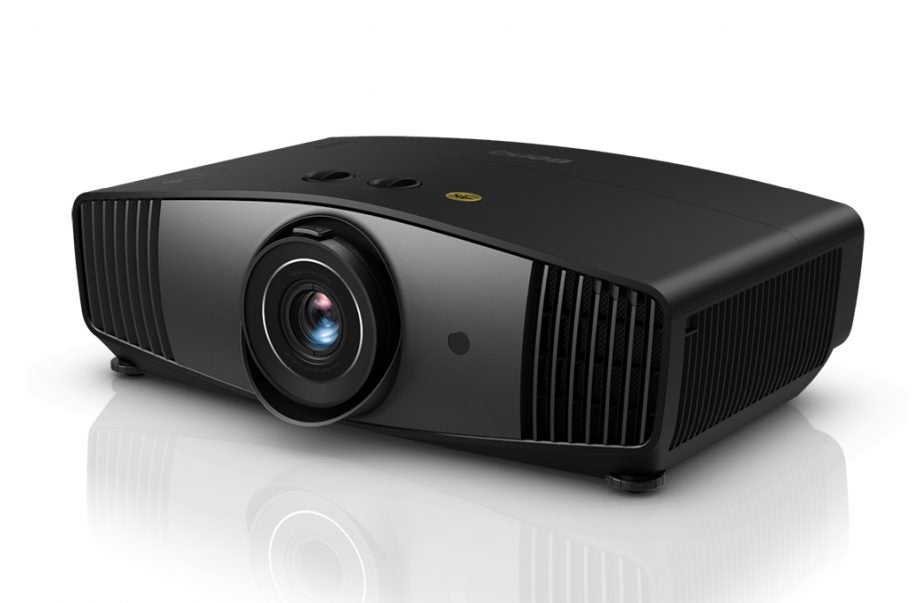

Verdict
The BenQ W5700 is a 4K HDR projector aimed squarely at the home cinema market. It boasts an impressive image, some useful features, and a previously unobtainable level of performance and image accuracy for a DLP projector.
Pros
- Superb image accuracy
- Effective HDR performance
- Excellent motion handling
- Good set of features
- Solid build quality
Cons
- Image could be brighter
- Black levels are weak
- Not native 4K
- Possible rainbow artefacts
- Rather noisy
Availability
- UKRRP: £2599
- EuropeRRP: €2999
- AustraliaRRP: AU$4599
Key Features
- DLP projection technology
- HDR10 and HLG support
Introduction
The BenQ W5700 is the flagship entry in the company’s CinePrime Series of DLP projectors. It supports Ultra HD 4K thanks to Texas Instruments’ XPR (Expanded Pixel Resolution) technology, and incorporates BenQ’s CinematicColor technology, which the manufacturer claims can reach 100% of the wide colour gamut (WCG) used by UHD Blu-rays
If true the W5700 will be the first single-chip DLP 4K home projector to achieve this milestone, and it’s achieved thanks to a six-segment colour wheel designed to generate those extra colours. BenQ is so confident its beamer can accurately deliver the industry colour standards of REC.709 and DCI-P3 that it even includes a verifying factory calibration report in the box.
The W5700 supports High Dynamic Range in the form of HDR10 and broadcast HLG. However, it also includes BenQ’s HDR-PRO technology for improved tone mapping, along with CinemaMaster Video+ picture processing. Unlike many of BenQ’s other projectors, this model is aimed squarely at the home cinema market – so let’s see if it can reach an appropriate level of performance.
Design
The W5700 certainly looks like a home cinema projector, with a large, well made chassis and an attractive matte-black finish. The design includes some useful touches, such as an anti-dust hood, louvered air intakes to reject dust from the cooling system, and a patterned lens ring to minimise light leakage from the optical engine.
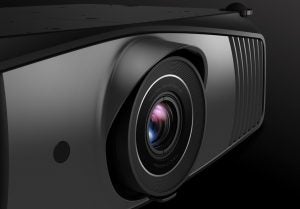
There are vertical and horizontal shift controls on the top of the chassis, and rings around the lens for zoom and focus. Unsurprisingly for a DLP projector, these are manual – which means no motorised controls for easier installation (especially focusing the lens) and no lens memory features for those using a scope ratio screen.
At the rear you’ll find a host of connections that includes two HDMI 2.0b inputs that are HDCP 2.2 compliant, and no fewer than three USB ports: USB 3.0 and 2.0 ports for media reading, and a second 2.0 port for power. The inclusion of the latter allows you to attach a streaming stick to one of the HDMI inputs.
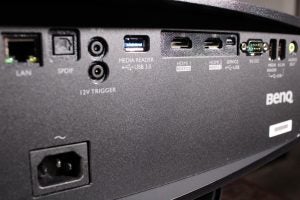
Since the W5700 is aimed at home cinema installations, there are no built-in speakers. However given that you can attach a streaming stick, BenQ includes an optical digital output and a 3.5mm analogue jack for connection to an audio system. Finally, there’s an RS-232 serial control connector, an RJ-45 LAN port, an IR-IN jack, and a 12V trigger for syncing with an electric screen.
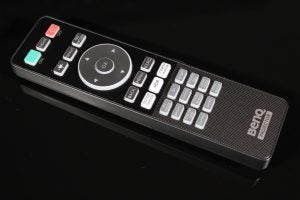
There are some basic controls at the rear of the W5700, which is handy if you ever misplace the included remote. This well-designed zapper comes in black to match the styling of the projector itself, and includes all the buttons you need to set up and operate the projector. There’s also a backlight, which is essential for controlling the projector in a darkened home cinema.
Features
The W5700 supports Ultra HD 4K (3840 x 2160 pixels) thanks to the incorporation of the latest version of Texas Instruments’ XPR (Expanded Pixel Resolution) technology. This means it doesn’t use a native 4K panel, instead it has a 1920 x 1080 panel that is shown four times in very fast succession to create the perception of a 4K image. It’s an optical trick but the results are effective.
The lens assembly is built around a precision 11-element and six-group, all-glass lens array that has been optimised for 4K. The lens is often the most overlooked aspect of a projector’s performance, but is also one of the most important. The single-chip DLP design eliminates convergence issues, and when combined with this lens, the pictures are incredibly sharp.
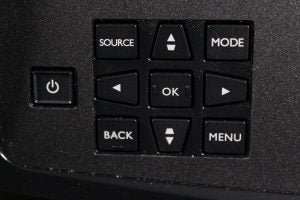
The projector uses a 245W lamp that generates a reasonable 1,800 lumens of brightness, and the contrast performance is boosted by a dynamic iris (with a claimed contrast ratio of 100,000:1). While the W5700 is hardly a light canon, that shouldn’t be an issue in a dedicated room. However if you are thinking of installing your projector in a normal living room, the brighter BenQ W2700 might prove a better (and cheaper) choice.
The wider colour performance is possible thanks to a newly-designed a six-segment RGBRGB colour wheel that generates the extra colours while keeping rainbows to a minimum (although you should demo the W5700 if you are susceptible to this particular artefact). BenQ employs a colour filter to reach 100% of DCI-P3, which unfortunately reduces the light output further, but that’s the kind of compromise you have to make for colour fidelity.
The included factory calibration report shows the model and individual serial number of the unit, and confirms compliance with D65 and 100% of REC.709 and DCI-P3 to a deltaE (error) measurement of less than three (which is the visible threshold). This is important because if the display matches these standards, you’re watching exactly what the content creators intended.
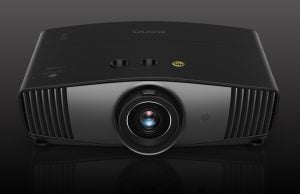
In testing, the W5700 actually did manage to produce white and colour measurements that had errors below three – thus confirming BenQ’s claims. The projector also delivered 100% of both the REC.709 and DCI-P3 colour spaces, which is genuinely impressive because in the past single-chip DLP beamers have struggled to even hit 100% of REC.709.
The W5700 supports High Dynamic Range, specifically HDR10 and Hybrid Log-Gamma (HLG), but also includes BenQ’s HDR-PRO technology for improved tone mapping. The projector also sports BenQ’s CinemaMaster Video+ processing feature, which offers controls for Colour Enhancer, Flesh Tone, 4K Pixel Enhancer, 4K Motion Enhancer.
Finally, the W5700 supports active shutter 3D, but you will need to buy suitable DLP 3D glasses in order to take advantage of this feature.
Set-up
The BenQ W5700 is simple to install, with the choice of placing it on a stand/shelf or up on the ceiling using an optional mount. You then simply adjust the size, position, and focus of the image using the manual lens controls. These are extremely flexible thanks to a 1.6X zoom and a lens shift that can move 60% either way vertically and 23% horizontally.
There’s a range of picture modes to choose from, with Cinema best for 1080p content and Dark Cinema designed for SDR content using a wider colour gamut. The projector automatically goes into the correct HDR mode when it receives an HDR signal, but you should make sure Wide Colour Gamut is switched on so you get the full benefit of W5700’s increased colour performance.
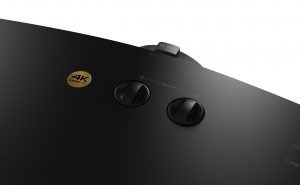
The CinemaMaster Video+ processing feature offers controls for Colour Enhancer, Flesh Tone, 4K Pixel Enhancer, and 4K Motion Enhancer. The first two seem redundant considering the colour accuracy, as is the last when you consider motion handling is a DLP strength. The 4K Pixel Enhancer is useful with lower resolution content, but in general you can leave these controls off.
This projector is fairly noisy in operation, although not because of the fan which is reasonably quiet at 30db. However, it’s the colour wheel that makes a high-pitched noise, as does the XPR feature, and the dynamic iris is noticeably noisy too. There is a Silent mode that turns XPR off to make the projector quieter, but then the image is limited to 1080p, which rather defeats the point.
Performance
The BenQ W5700 delivers an impressive level of picture quality, and is one of the best single-chip DLP projectors that we have tested to date.
It doesn’t just excel in terms of its accuracy, but also manages to deliver a detailed image despite not using a native 4K panel. A show like The Expanse often looks spectacular in Ultra HD, and the XPR wizardry produces perceived 4K images that don’t reveal any pixel structure, even when viewed up close.
The shots of ships gliding through space are smooth and judder-free, while the reflected sunlight is suitably bright and space appears appropriately black even with the dynamic iris off. The projector’s adherence to REC.709 also ensures accurate colours and excellent flesh tones.
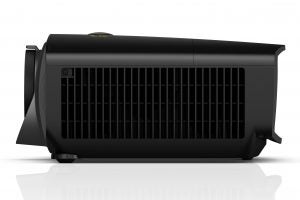
The upscaling is equally as impressive, and a show like Star Trek: Discovery (which is presented in 1080p) retains plenty of detail. The HDR is also an eye-opener, with the bright lens flares and colours on the bridge of the USS Enterprise presented in all their glory.
The W5700’s tone mapping crafted some impressive images, but for the best results you’ll need to engage the dynamic iris. This increases the brightness and deepens the blacks without noticeably pumping the image – although you can hear it working, which is annoying.
The film Lucy includes some difficult mixed-contrast content that allows the W5700 to display its strengths and one specific weakness. The 4K image is full of intricate details and the colours look spectacular, while highlights are delivered with a pleasing intensity.
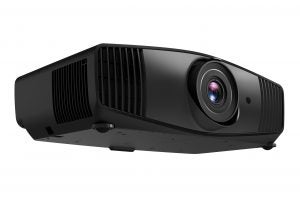
However, even with the dynamic iris on, the shadows lack detail and the blacks themselves are more a very dark grey. This is an inherent weakness of DLP, but since this projector is aimed at home cinemas, this limitation will be more apparent in a blacked-out room.
While the tone mapping is effective, the film Overlord (which largely takes place at night) pushes the projector’s HDR capabilities to its limits. The greens and browns that dominate the film’s colour scheme are nuanced but the image is often too dark, although using the HDR Brightness control can help.
While 3D is dead as far as TVs are concerned, it remains popular with projector owners. DLP has always been ideal for 3D, and this projector demonstrates why, with a complete absence of crosstalk, smooth motion, and images that are detailed and accurate.
Due to the use of active shutter glasses, the brightness is reduced but the 3D images in Ant-Man and the Wasp look awesome – especially when the frame opens out for the IMAX sequences. The result is a great all-round projector that can deliver the goods with 4K, SDR, HDR, and 3D.
Should you buy it?
If you want impressive colour accuracy The BenQ W5700 is an excellent projector that delivers previously unheard-of colour coverage for a DLP display and a remarkable level of accuracy. The 4K might be delivered via XPR trickery, but the results are impressive with detailed images.
If you want better black levels As is always the case with DLP beamers, the blacks could be better and there’s a lack of shadow detail – both limitations that will be more obvious in a darkened home cinema. A dynamic iris helps but also adds to what it already a noisy projector.
Final Thoughts
BenQ has designed this model specifically for use in home cinemas, and includes a number of useful features. Its brightness is somewhat limited but the HDR performance remains impressive, while motion handling and 3D are also excellent.
Overall the W5700 is an impressive effort from BenQ, and certainly justifies its price. However, this sector of the market is competitive, and it’s currently hard to beat the Epson EH-TW9400. This 3-chip LCD model costs the same and supports 4K HDR, but also includes useful features such as motorised lens controls and a lens memory feature.








